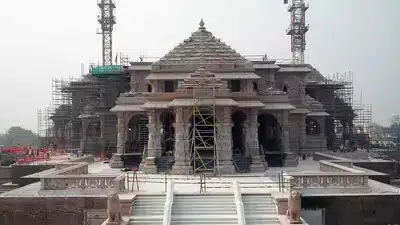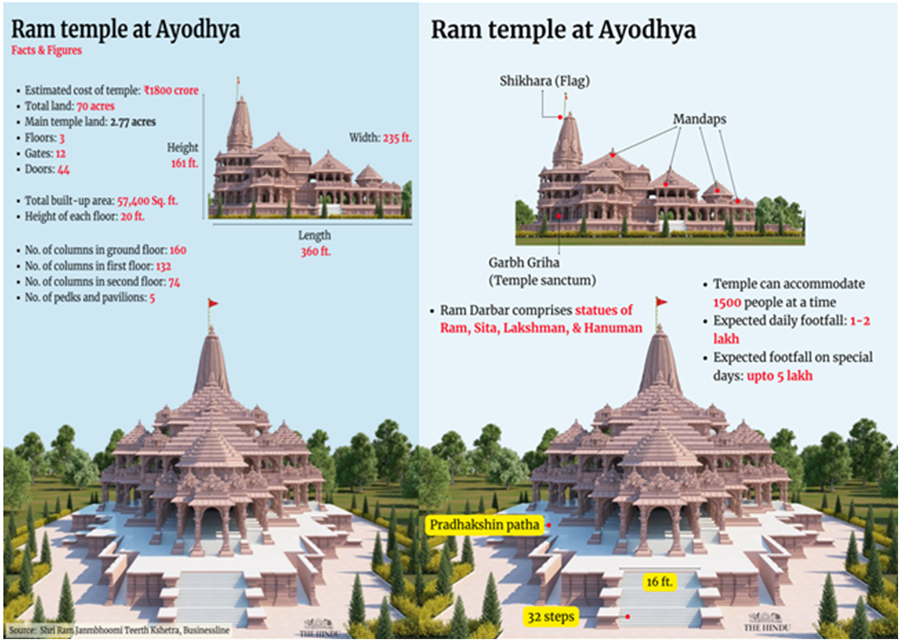What’s in Today’s Article?
- Why in News?
- Major Features of the Ram Temple
Why in News?
- A new landmark of India – both structural and spiritual – rises on Ayodhya’s horizon as a new-age architectural marvel of elegant sandstones, diligently carved by craftspeople with dedication and devotion to Lord Ram.
Major Features of the Ram Temple
- Main Complex:
- The Ram Mandir is a Hindu temple in Ayodhya, Uttar Pradesh. It is located at the site of Ram Janmabhoomi, the birthplace of Lord Rama.
- No iron or steel has been used in the construction of the grand structure. Stones have been sourced from Rajasthan’s Bansi Paharpur area.
- The temple complex, built in the traditional Nagara style, will be 380 feet long from the east to the west, 250 feet wide and 161 feet high.
- Each floor of the temple will be 20 feet high and have a total 392 pillars and 44 gates.
- Around the grand temple is a rectangular periphery called percota, a feature found in temples in south India, but not generally in north India.
- The percota will be 14 feet wide and the periphery span 732 metres. The temple will be nestled within the percota periphery.
- Images of Lord Hanuman, other deities, peacocks and flower patterns have been carved onto the stones, lending the structure a divine look.
- More than 3,000 kg of flowers of over 20 varieties have been used to decorate the grand structure.
- Main Entrance:
- Ornate statues of elephants, lions, Lord Hanuman and Garuda were installed at the main entrance leading to the temple earlier this month.
- These statues have also been made using sandstone brought from Bansi Paharpur.
- Green Complex:
- A major part of the temple compound will be a green area with hundreds of trees.
- About 70 per cent of the complex will be a green area.
- The complex will have two sewage treatment plants — a water treatment plant and a dedicated electricity line from the power house.
- The fire brigade post will be able to source water from an underground reservoir.
Last updated on August, 2025
→ UPSC Mains Admit Card 2025 will be released soon at www.upsc.gov.in.
→ UPSC Mains 2025 will be conducted on 22nd August 2025.
→ UPSC Notification 2025 was released on 22nd January 2025.
→ UPSC Calendar 2026 is released on 15th May, 2025.
→ UPSC Prelims Question Paper 2025 and Unofficial Prelims Answer Key 2025 are available now.
→ UPSC Prelims Result 2025 is out now for the CSE held on 25 May 2025.
→ The UPSC Vacancy 2025 were released 1129, out of which 979 were for UPSC CSE and remaining 150 are for UPSC IFoS.
→ UPSC Prelims 2026 will be conducted on 24th May, 2026 & UPSC Mains 2026 will be conducted on 21st August 2026.
→ The UPSC Selection Process is of 3 stages-Prelims, Mains and Interview.
→ UPSC Result 2024 is released with latest UPSC Marksheet 2024. Check Now!
→ UPSC Toppers List 2024 is released now. Shakti Dubey is UPSC AIR 1 2024 Topper.
→ Also check Best IAS Coaching in Delhi
















